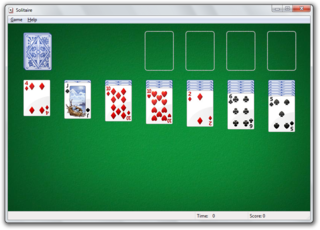Solitaire (Windows, 2007)
| Solitaire |
|---|
|
Developers: Oberon Media,
Microsoft
|
The 2007 version of Solitaire included with Windows Vista and 7 is a reworked version of the 1990 original with shiny Frutiger Aero themed graphics and some new features. Other than that, though, it plays exactly the same.
To do:
|
Contents
Debug Mode
By setting the internal g_bDebugEnabled variable to a nonzero value, various debugging features are enabled. This value isn't written to by the game, so it must be set manually.
Menu
Instead of the normal menu (resource 102), the game loads this alternative one (resource 103) from Solitaire.exe.mui. Most of it is self-explanatory, but "Toggle Deck Lock" appears to have no effect.
Cheat Code
Holding Ctrl + Alt + Shift while clicking on the deck causes only one card to be drawn regardless of the Draw Three options. It also enables you to move any card or bunch to any other stack irrespective of card color or number.
Block Mode
Holding F6 causes the playfield to be rendered in gray with ever grayer boxes representing the cards.
Pause Mode
Pressing Home causes the display to freeze. Nothing else stops, so the time continues in timed games and sound effects still play, but with no visual feedback. Pressing End resumes the display. Insert can be used to toggle this on and off.
Solver Debugging
A different debugging option can be enabled by launching the executable with the -solverdebug argument. This is also present in Spider Solitaire.
Logging
Like with debugging, there are two internal variables that control UTF-16 logging either to log.txt in the current directory (g_uiFileMask) or redirected standard output (g_uiConsoleMask). Also like debugging, they are not written to by the game so it must be enabled manually.
A sample log:
SolLogGeneral: (673) SolitaireGame::FindHigherCardToPutOnStack() - Not a main stack, don't bother checking. CardLibLogGeneral: (674) CardStack::SetHighlight()::bHighlight == false CardLibLogGeneral: (675) Card::SetHighlight()::bHighlight == false 0x00002000: (676) Hide tip Rendering: (884) SetState: 260 Rendering: (885) (RenderManager.cpp:2156) Present Failed: 88760868(D3DERR_DEVICELOST) Rendering: (886) (RenderManager.cpp:1704) Resuming after lost device Rendering: (887) (Font.cpp:691) Invalidating a font cache Rendering: (888) (Font.cpp:691) Invalidating a font cache Rendering: (889) (RenderManager.cpp:2253) Reset: 800 x 496 format 22 Rendering: (890) (RenderManager.cpp:1465) RecreateDefaultResources() UI: (891) Recreating font: Segoe UI UI: (892) Recreating font: Segoe UI Rendering: (893) (RenderManager.cpp:150) CreateCachedBackBuffer() Rendering: (894) SetState: 4096 Core: (909) Engine_GotFocus() Timekeeping: (910) Reset timers Core: (911) Engine_LostFocus() Core: (912) Engine_GotFocus() Timekeeping: (913) Reset timers Rendering: (914) (RenderManager.cpp:2369) Saved the back buffer for cached presentation CardLibLogGeneral: (915) CardStack::SetEnabled()::bAccess == true Core: (916) Engine_LostFocus()
With logging and debug mode enabled, pressing F11 dumps the in-use images and sounds to the log.
XInput Support
An interesting feature that isn't documented anywhere (Help Menu-wise) is XInput (gamepad) support - if the game detects an Xbox 360 controller plugged into one of your USB ports, the P1 corner on the controller will light up, signifying the controller can be used.
Possibly undocumented because Microsoft thought people were too used to the traditional controls, and a gamepad wouldn't work well for a card game. It's a neat little feature, nonetheless.
Controls
| Button | Effect |
|---|---|
| Left analog stick/D-Pad/Shoulder Buttons/Triggers | Moves the cursor. Oddly, they can also be used to navigate the menu bar. |
| B/Back | Undoes the previous move. |
| A/X | Selects the card the cursor is on. Moving the cursor onto another card and pressing A or X again moves the previous card onto the stack. Double-tapping either button moves a card to the home stack. |
| Y/Start | Opens the Game Menu. |
| Introduced in Windows 1.0 | Reversi (1985) |
|---|---|
| Introduced in Windows 3.x | Hearts (1993) (Prototypes) • Minesweeper (1990) (Prototypes) • Solitaire (1990) (Prototypes) |
| Introduced in Windows 95 | FreeCell (1991) • Hover! (1995) (Prototypes) |
| Introduced in Windows 2000 | 3D Pinball: Space Cadet (Prototypes) • Spider Solitaire (1998) (Prototype) |
| Introduced in Windows XP | InkBall |
| Introduced in Windows Vista | Chess Titans • FreeCell (2007) • Hearts (2007) • Minesweeper (2007) • Purble Place (Prototypes) • Solitaire (2007) • Spider Solitaire (2007) |
| Introduced in Windows 8 Developer Preview | 5 in a Row • Labyrinth • Treehouse Stampede! • Zero Gravity |
| Introduced in Windows 10 | Microsoft Solitaire Collection |
| Other | GeoSafari for Bob |
| See also | |
| Microsoft Entertainment Pack | |
- Pages missing developer references
- Games developed by Oberon Media
- Games developed by Microsoft
- Pages missing publisher references
- Games published by Microsoft
- Windows games
- Pages missing date references
- Games released in 2007
- Games released in January
- Games released on January 30
- Games with unused code
- Games with debugging functions
- To do
- Bundled Windows Games
Cleanup > Pages missing date references
Cleanup > Pages missing developer references
Cleanup > Pages missing publisher references
Cleanup > To do
Games > Games by content > Games with debugging functions
Games > Games by content > Games with unused code
Games > Games by developer > Games developed by Microsoft
Games > Games by developer > Games developed by Oberon Media
Games > Games by platform > Windows games
Games > Games by publisher > Games published by Microsoft
Games > Games by release date > Games released in 2007
Games > Games by release date > Games released in January
Games > Games by release date > Games released in January > Games released on January 30
Games > Games by series > Bundled Windows Games


